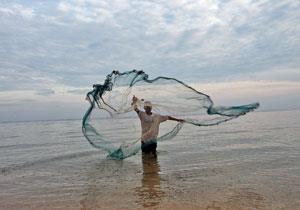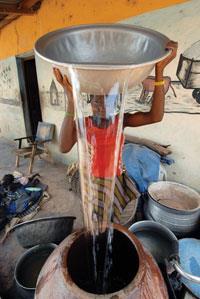A Global Experiment for the International Year of Chemistry
-
The Global Experiment has been designed for use across a range of educational settings worldwide
-
Students will discover the power of chemistry to provide reliable information and data within our society

This article is reprinted from Chemistry International, September-October 2010.
In 2011, the International Year of Chemistry, school students around the world will be invited to explore one of Earth's most critical resources, water. The results of their investigations will contribute to a Global Experiment, which will possibly become the biggest chemistry experiment ever. The global experiment - an initiative of the IUPAC Committee on Chemistry Education - has been developed to appeal to students from primary school to senior high school. The activities that make up the experiment will help students appreciate the role of chemistry in issues of water quality and purification. At the same time, students will contribute to an online global map, reporting on their investigations of water quality and water treatment.

The Global Experiment directly addresses the IYC goal of increasing the public appreciation and understanding of chemistry in meeting world needs and encouraging interest in chemistry among young people. The central theme of the experiment will be Water: A Chemical Solution. This will provide an outstanding educational opportunity to learn about the key role of chemistry in providing clean, safe water and the challenge of meeting the Millennium Development Goal of greatly improving access to safe drinking water before 2015. This activity will be used to emphasise the close relationships between water and climate change, human health, and energy security.
The theme for the global experiment project - Water: A Chemical Solution - implies the dual meaning of solution. Firstly, solutions are the answers that chemistry can provide to questions about delivering safe water to people all over the world. Secondly, in the chemical sense, the term is helpful for introducing important chemical principles such as pH, salinity and solubility.
In the global experiment, teachers will involve classes of students in the investigation. Consider for a moment how many students might participate - 100 countries, 1000 schools per country, 10 classes per school, and 10 students per class would lead to millions of participants and a giant experiment! With such an extensive reach comes a responsibility to achieve valuable educational goals. The context of water provides relevance and the experiment will give students learning experiences that are engaging and edifying so that they learn valuable practical skills and useful chemistry. At the same time, students will discover the power of chemistry to provide reliable information and data within our society.
The activities
The activities that make up the experiment have been designed to require minimal equipment and resources, but at the same time, allow increasing levels of sophistication. Four activities, which are being tested, have been developed to examine local water sources:
- Two activities related to water treatment involve purification by filtration and evaporation. The filtration activity will investigate local water treatment methods and results will be reported on a global map. This activity can be elaborated to investigate disinfection.
- The other two activities will involve tests relating to water quality, namely measuring acidity and salinity. The measurements also will be reported on a global map.
These activities have been designed to be used as a stand-alone experiment for classes that want to participate in the event, or to be built into an existing water-related curriculum unit. Many science or environmental units in existing school curricula involve more extensive measurements of water quality and treatment and will require, at the most, minor adjustments to include reporting for the global maps. The resources provided can simply be added to those already used in the school. In the other cases, the resource materials will provide detailed procedures and background knowledge to allow teachers at each level of schooling to implement them with their class and enjoy the reporting of results to the global maps as a culminating event.
Dissemination
The Global Experiment is generating interest among a wide variety of organisations in science and in education. Collaboration and support will be critical for the dissemination and implementation of the experiment:
- National adhering organisations affiliated with IUPAC or UNESCO will be invited to join in the process of distributing information and resources associated with the Global Experiment. Their collaboration will be acknowledged on the Global Maps and they will be able to draw on the results of the experiment for their own use.
- Active partnerships with national and transnational organisations, both chemical and educational, are being explored and arranged to help the process of developing the infrastructure for the experiment and its dissemination. Organisations such as the European Chemical Industry Council, CEFIC and the American Chemistry Council are providing direct support. The European Schoolnet is providing support and expertise in both development and implementation through its European members and international associates.
- Partnerships with organisations specifically focused on water issues (e.g. the organisers of World Water Monitoring Day, the Water Environment Federation and the International Water Association) are being discussed.
Dissemination of the experiment to countries that do not have affiliated organisations will be carried out through invitations to national education authorities and by direct communication via the Internet.
The resources for the experiment will be placed on the Global Experiment website along with a link for teachers to register their school or class. This will limit the volume of conventional mail required for schools without internet access.
Sponsorship is being sought for kits that would be distributed to areas in which schools have few science resources. The kits will contain sufficient materials for the students to participate in the data collection for the Global Experiment.
The experiment
The Global Experiment will be launched early in the International Year of Chemistry. A dedicated website will be open for data submission at that time and will remain available through the culminating event. The experiment is being developed as a stand-alone student investigation that will mesh with material that many schools already cover around the topic of water. The experiment will offer a range of participation levels.
It is expected that most teachers will work with their classes to carry out the four activities, which will have explicit instructions and background materials. These will be helpful for teachers who don't have science backgrounds. In their current round of testing, the activities give students the opportunity to learn about two ways in which chemistry contributes to our understanding of water quality and water treatment.
The activities cover important topics and conceptual understanding in science and also provide a variety of opportunities to learn important experimental and data gathering skills.
- Acidity: Students will use colourful indicators, either from their school's supplies, or from the resource kit, to measure the pH of their local body of water. They will be learning about acidity, one of the most common chemical properties encountered around the home. At the same time, they will be learning good experimental techniques to test the reliability of their results. Combining the results for the class will provide a robust result that can be recorded on the Global Map.
- Salinity: The salinity activity will give students the opportunity to use either a homemade or commercial meter to measure the conductivity of water samples. Students will learn about salts and determine concentrations of salts in solutions.
- Filtration: In the filtration activity students will use household materials to build a water filtration unit and identify the efficiency of different filtration materials. Then, as a follow-up, they will carry out a treatment of the water. In addition, they will research the methods of their local water treatment plant and report the results of their research to the Global Experiment website.
- Solar Still: Students will explore an alternative way of purifying water using a solar still, learning about the distillation process and the states of matter. The activity will provide students with the opportunity to design and build their own more efficient stills.
Alternatively, teachers can select to undertake a single activity if they want their students to collect some data and contribute to the Global Experiment without using the other activities, perhaps because water is studied at a different year level. If, on the other hand, an existing curriculum unit studying water is part of the curriculum during 2011, appropriate parts of the Global Experiment activities can be added selectively to the existing curriculum and give students the chance to participate in the experiment.
In the classroom

The Global Experiment has been designed for use across a range of educational settings. Each of the activities comes with resources to help teachers implement the activities at the level of sophistication appropriate for their classes. For example, the acidity activity, with the working title of measuring the pH of the Planet, has been written for three levels of students:
- In the middle or upper primary school, students are introduced to acidity as a concept related to experiences they have had in the home. They learn about pH simply as a number associated with acidity. In an ancillary activity, teachers are encouraged to explore acidity with their students using home-made red cabbage indicators.
- In the junior high school where students are learning about ions and simple chemical formulae, they learn to associate acidity with hydrogen ions and the strength of acids.
- In senior high school they learn about the logarithmic relationship between hydrogen (or hydronium) ions and pH. At the same time, they extend their measurements of pH with pH meters if they are available in the school.
The website
The interactive Global Experiment website will be the central source of information both for schools and for other interested groups. The site will be the sole portal for reporting data from the experiments. Resources being developed for the project include the following:
- A toolkit for schools containing the necessary materials for carrying out the activities. These materials will be available for downloading and will include a teacher guide, activity protocols, suggestions for how the activities could be integrated into the curriculum and guidance on how and where to order special equipment. Logos and branding materials are being developed for publicising the experiment within schools and in the wider community.
- A registration site for schools where teachers can register their interest in the project and sign up their school to the activities.
- A mapping tool that will display the global data as it is submitted and also display school information, including a Google map of schools taking part in the experiment.
- School co-ordination tools that will facilitate collaboration and data submission and may include file archives, an internal messaging system and chat groups and forums. The possibility of students being invited into this space for debates and/or chats with experts is being explored.

Tony Wright (tony.wright@uq.edu.au) and Javier Garcia-Martinez (j.garcia@ua.es) are joint chairs of the Global Experiment Subcommittee of the IUPAC Committee on Chemistry Education and of the IUPAC Global Chemistry Experiment for the International Year of Chemistry project.



![Global experiment 1007 086 300tb[1]](https://d1ymz67w5raq8g.cloudfront.net/Pictures/100x67/6/4/4/113644_globalexperiment_1007_086_300tb1.jpg)



No comments yet